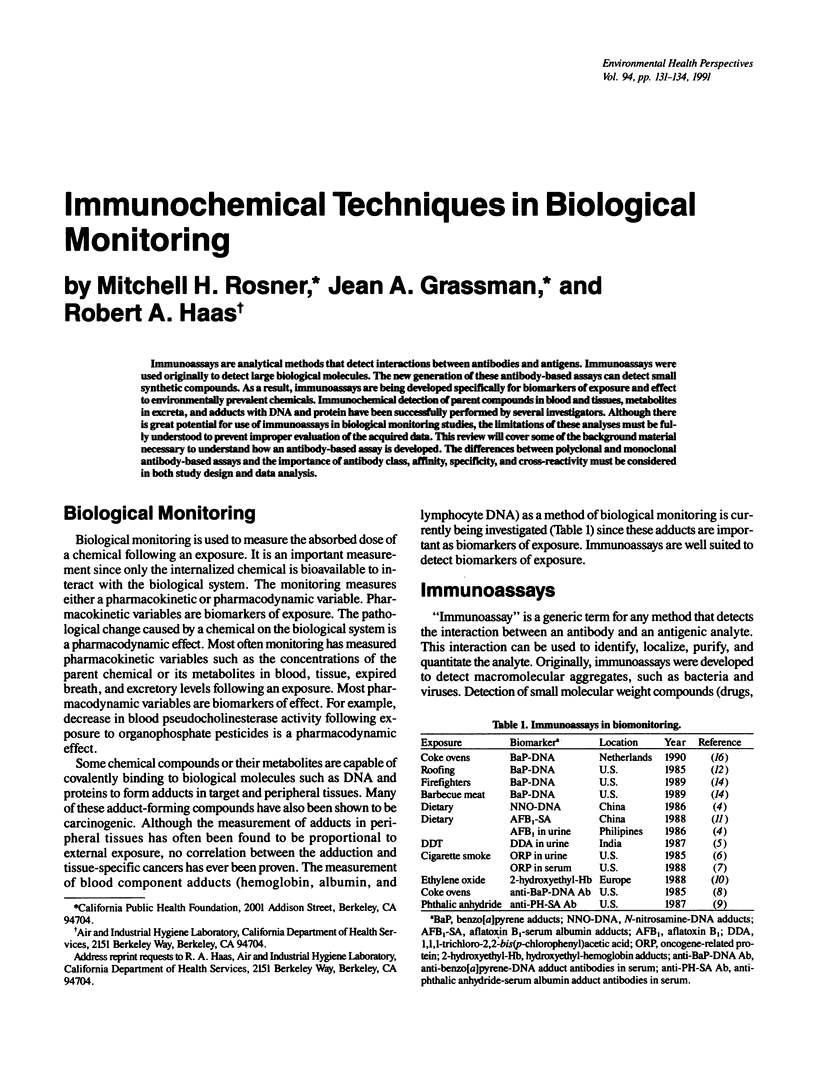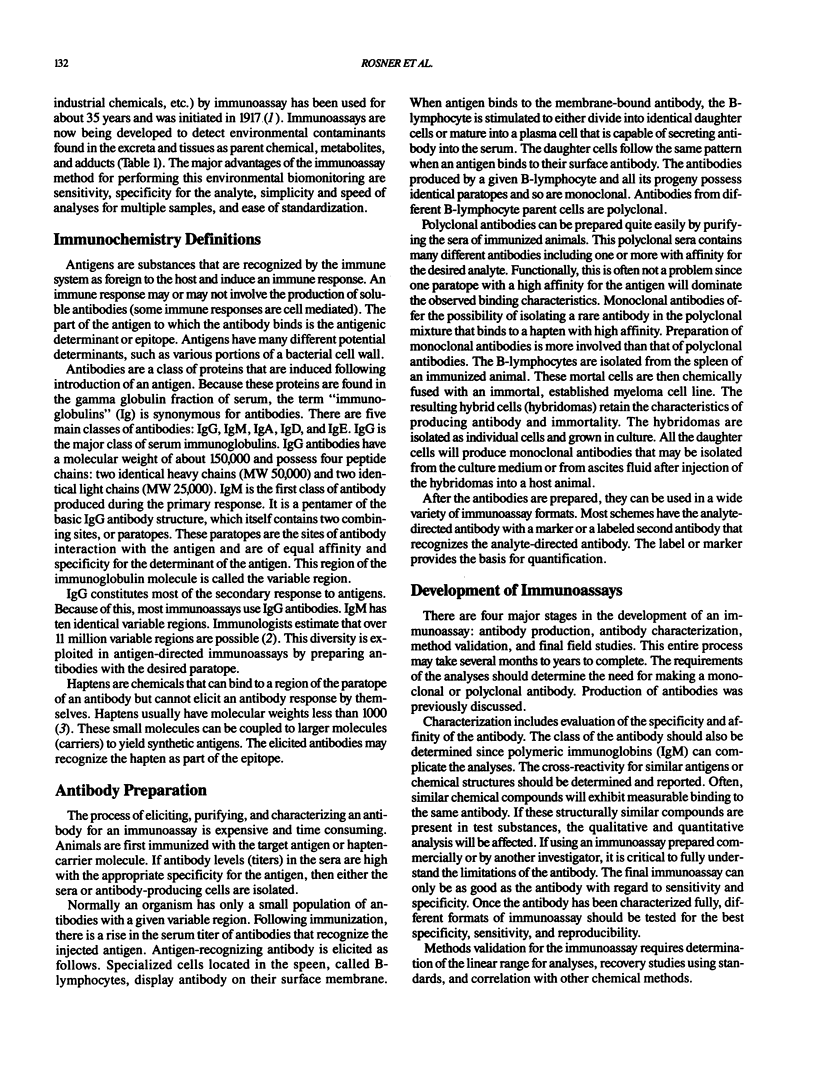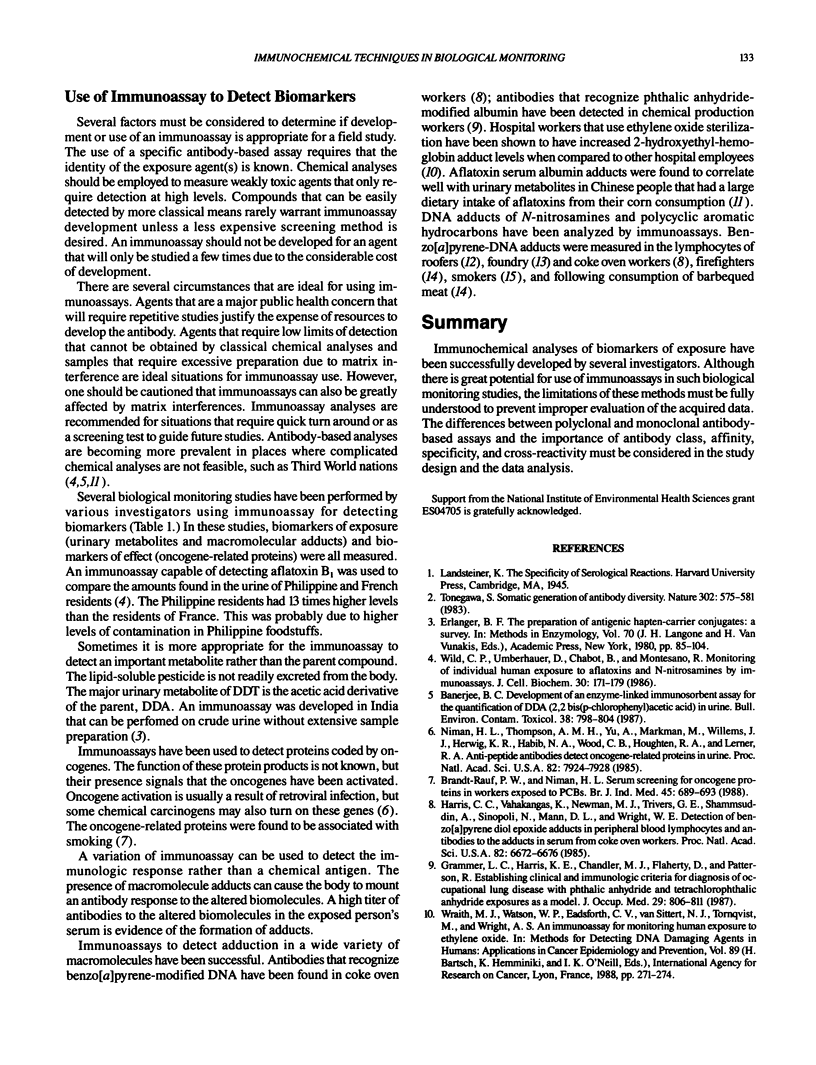Abstract
Immunoassays are analytical methods that detect interactions between antibodies and antigens. Immunoassays were used originally to detect large biological molecules. The new generation of these antibody-based assays can detect small synthetic compounds. As a result, immunoassays are being developed specifically for biomarkers of exposure and effect to environmentally prevalent chemicals. Immunochemical detection of parent compounds in blood and tissues, metabolites in excreta, and adducts with DNA and protein have been successfully performed by several investigators. Although there is great potential for use of immunoassays in biological monitoring studies, the limitations of these analyses must be fully understood to prevent improper evaluation of the acquired data. This review will cover some of the background material necessary to understand how an antibody-based assay is developed. The differences between polyclonal and monoclonal antibody-based assays and the importance of antibody class, affinity, specificity, and cross-reactivity must be considered in both study design and data analysis.
Full text
PDF



Selected References
These references are in PubMed. This may not be the complete list of references from this article.
- Banerjee B. D. Development of an enzyme-linked immunosorbent assay for the quantification of DDA (2,2-bis(p-chlorophenyl) acetic acid) in urine. Bull Environ Contam Toxicol. 1987 May;38(5):798–804. doi: 10.1007/BF01616704. [DOI] [PubMed] [Google Scholar]
- Brandt-Rauf P. W., Niman H. L. Serum screening for oncogene proteins in workers exposed to PCBs. Br J Ind Med. 1988 Oct;45(10):689–693. doi: 10.1136/oem.45.10.689. [DOI] [PMC free article] [PubMed] [Google Scholar]
- Erlanger B. F. The preparation of antigenic hapten-carrier conjugates: a survey. Methods Enzymol. 1980;70(A):85–104. doi: 10.1016/s0076-6879(80)70043-5. [DOI] [PubMed] [Google Scholar]
- Everson R. B., Randerath E., Santella R. M., Cefalo R. C., Avitts T. A., Randerath K. Detection of smoking-related covalent DNA adducts in human placenta. Science. 1986 Jan 3;231(4733):54–57. doi: 10.1126/science.3941892. [DOI] [PubMed] [Google Scholar]
- Grammer L. C., Harris K. E., Chandler M. J., Flaherty D., Patterson R. Establishing clinical and immunologic criteria for diagnosis of occupational immunologic lung disease with phthalic anhydride and tetrachlorophthalic anhydride exposures as a model. J Occup Med. 1987 Oct;29(10):806–811. [PubMed] [Google Scholar]
- Harris C. C., Vahakangas K., Newman M. J., Trivers G. E., Shamsuddin A., Sinopoli N., Mann D. L., Wright W. E. Detection of benzo[a]pyrene diol epoxide-DNA adducts in peripheral blood lymphocytes and antibodies to the adducts in serum from coke oven workers. Proc Natl Acad Sci U S A. 1985 Oct;82(19):6672–6676. doi: 10.1073/pnas.82.19.6672. [DOI] [PMC free article] [PubMed] [Google Scholar]
- Liou S. H., Jacobson-Kram D., Poirier M. C., Nguyen D., Strickland P. T., Tockman M. S. Biological monitoring of fire fighters: sister chromatid exchange and polycyclic aromatic hydrocarbon-DNA adducts in peripheral blood cells. Cancer Res. 1989 Sep 1;49(17):4929–4935. [PubMed] [Google Scholar]
- Niman H. L., Thompson A. M., Yu A., Markman M., Willems J. J., Herwig K. R., Habib N. A., Wood C. B., Houghten R. A., Lerner R. A. Anti-peptide antibodies detect oncogene-related proteins in urine. Proc Natl Acad Sci U S A. 1985 Dec;82(23):7924–7928. doi: 10.1073/pnas.82.23.7924. [DOI] [PMC free article] [PubMed] [Google Scholar]
- Perera F., Santella R., Poirier M. Biomonitoring of workers exposed to carcinogens: immunoassays to benzo(a)pyrene-DNA adducts as a prototype. J Occup Med. 1986 Oct;28(10):1117–1123. doi: 10.1097/00043764-198610000-00038. [DOI] [PubMed] [Google Scholar]
- Shamsuddin A. K., Sinopoli N. T., Hemminki K., Boesch R. R., Harris C. C. Detection of benzo(a)pyrene:DNA adducts in human white blood cells. Cancer Res. 1985 Jan;45(1):66–68. [PubMed] [Google Scholar]
- Tonegawa S. Somatic generation of antibody diversity. Nature. 1983 Apr 14;302(5909):575–581. doi: 10.1038/302575a0. [DOI] [PubMed] [Google Scholar]
- Wild C. P., Umbenhauer D., Chapot B., Montesano R. Monitoring of individual human exposure to aflatoxins (AF) and N-nitrosamines (NNO) by immunoassays. J Cell Biochem. 1986;30(2):171–179. doi: 10.1002/jcb.240300206. [DOI] [PubMed] [Google Scholar]
- van Schooten F. J., van Leeuwen F. E., Hillebrand M. J., de Rijke M. E., Hart A. A., van Veen H. G., Oosterink S., Kriek E. Determination of benzo[a]pyrene diol epoxide-DNA adducts in white blood cell DNA from coke-oven workers: the impact of smoking. J Natl Cancer Inst. 1990 Jun 6;82(11):927–933. doi: 10.1093/jnci/82.11.927. [DOI] [PubMed] [Google Scholar]


